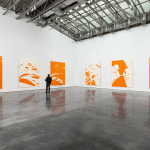
Following the chaos of World War I, artists moved away from the experimental, forward-thinking ideas of Cubism, Futurism, and Expressionism toward a retrograde classicism that embraced order, synthesis, organization, and what were seen as “enduring values.” Artists’ depictions of the human figure became idealized, monolithic forms, perhaps in response to the horrors witnessed during the war. “Chaos and Classicism: Art in France, Italy, and Germany, 1918�1936“ traces this interwar trend as it worked its way from a poetic, mythic idea in the Parisian avant-garde; to a political, historical idea of a revived Roman Empire, under Benito Mussolini; to a neo-Platonic High Modernism at the Bauhaus, and finally to the chilling aesthetic of nascent Nazi culture.”(1)
The show is amazing, not for the quality of the work included, but because it examines and clearly illuminates how visual art reflects the political values of a culture.� Picasso’s classicist phase was familiar to me, but the exhibition puts the known Picasso paintings into a larger and more disturbing political context. During these turbulent years, some war-weary artists were easily enlisted as political propagandists, others sincerely believed in the move toward classicism, and others painted classicist tropes infused with quiet despair. I wonder what we might have done in similar circumstances.
In his Top Ten list of 2010, NY Mag critic Jerry Saltz agrees, suggesting that guest curator Kenneth Silver has revised art history outright. “Thanks to his show, we have a clearer, less formalist idea of what was going on across Europe between the wars. As we�ve long suspected, art didn�t simply march forward from Cubism in the teens through Dada and Surrealism in the twenties and thirties; it made some strange pit stops along the way, into an often disturbing realism.”
In The Brooklyn Rail, Tom Micchelli suggests that the exhibition effectively shows how sinister the turn toward classicism was. “For every purist like Le Corbusier (1887 � 1965), who was among the few to extract nobility from its underlying geometry; or nouveau-riche avant-gardist like Pablo Picasso (1881 � 1973), who entertained classicism as a passing fancy; or dissident like Hannah H�ch (1889 � 1978), who called it out as reactionary propaganda, there were dozens of toadies, greed heads, ideologues, and na�fs who placed their talent, such as it was, at the service of image-conscious politicians and fashion-conscious oligarchs….This failure of inquiry, both political and aesthetic, is at the source of the leaden sentimentality suffocating the majority of the works in this exhibition. Instead of confronting the complexities of their subjects, the artists streamlined them according to a set of principles that would ensure the timelessness of their work (but in the end delivered it dead on arrival).”
Hrag Vartanian at Hyperallergic: “The genius of the show is that it doesn�t rely on masterpieces by widely recognized masters to make the case that modern classicism deserves our attention….The fascinating thing is that it doesn�t chart a movement, a style, or an ideology, as much as a mood, and it�s fascinating to see how during two decades in the early twentieth century artists in France, Italy, and Germany were often looking back to see their precarious present.”
Stephen Squibb in Idiom: “The show�s immediate success, palpable almost upon arrival, speaks not only to the diligence and command of its curators, but to a deeply felt resonance between its moment and our own. What makes Chaos of lasting interest, however, is precisely the extent to which it disrupts this easy parallel: it is difficult to walk away from this exhibition with one�s �we are Weimar� fatalism fully intact. Illuminated instead are the differences between our homegrown forms of Rightist reaction � at least at the level of art and culture � and those of Italian and German fascism.”
























